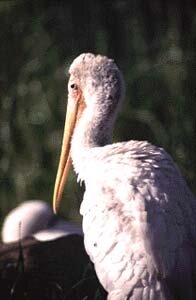
 Yellow-Billed Stork
Yellow-Billed Stork
scientific name
Mycteria ibis
size
Bill. 205-242
Tail Length. 168-183
Tarsus. 197-229
Wing. 455-513
Wingspan. 1500-1650
sexes alike " female slightly smaller
characteristics
Adaptations/Coloration. male adult forehead & face naked & hindcrown & neck grayish white " back, upper wing-covert, under wing-covert, breast, & belly white - more or less tinged pink with pinkish or reddish tips to some feathers " wing feathers & tail black " bill bright yellow " face bare skin orange-red " eyes gray-brown " legs red " breeding colors intensify - bill deeper yellow, face bare skin bright red, white plumage suffused pink, & wing-coverts broadly tipped crimson
Bill. long " slightly decurved " thick at base
Feeding. remarkable adaptation " involves quickest known muscular reflex " allows almost all food caught in water
Neck. outstretched in flight
Tail. short " not wedge-shaped
Voice. generally silent " adults bill-clatter with very hollow sound " at breeding colonies "fizzing" whining call or hissing screams (resemble squeaking hinge) " young beg with repeated monotonous braying
behavior
Activity. inactive " rests day " squat on tarsi
Feeding. slightly open bill immersed to near base " stirs bottom mud with one foot " may open wing to shade water " bill instantly snaps when prey moves " may also walk along, plunging bill repeatedly into water & weeds, snapping any prey located " seized prey manipulated, wriggling, between mandibles, then swallowed (usually alive)
Flight. strong quick wing-beats " thermals for far travel
Flock. never very large " usually found in large swamps, along lake margins, larger rivers, irrigated rice fields, & other large areas of marsh & water " may occur at small pools & streams, but not for long " often associates with other storks, herons, & pelicans at favored resting places
Movement. slow " deliberate " exception = when threatening others
Personality. gregarious (usually)
Roosts. ground, sandbanks, lake margins, & sometimes favorite trees nightly
reproduction/life span
Courtship. female approaches "display preens"
Nest. male chooses site " both build in 7-10 days " normally in trees (usually tall acacias & baobobs) " located high up or on top, low trees acceptable in flooded areas " small & large colonies " often & usually with other storks, herons, &cormorants, singly & small groups " maximum 10-20 per tree
Incubation. period not recorded " c. 30 days
Hatching. intervals of 2+ days
Eggs. 2-3 (maybe 4) " laid alternate days
Newborn. helpless " cant stand " require continuous brooding at first " at 10 days 2nd down emerges & becomes pure white " fledgling period c. 55 days " further good details lacking
diet
Wild. crustaceans, frogs, small fish, some aquatic insects, perhaps small mammals, & worms
habitat/range
permanently present in Zambia, Zimbabwe, & most tropical East Africa
Movements. irregular " somewhat nomadic " poorly documented " East Africa, moves locally " West Africa, regularly migrates south in dry season & north in wet season " South Africa, definitely migrant, arrives in Oct & leaves Apr, remaining through southern summer " resident widespread in aquatic habitats, including alkaline lakes & marine mudflats throughout tropical Africa & less in forested areas " elsewhere, may move locally " some areas, permanent resident, though probably congregate locally to breed
other
can be confused with White Stork (Ciconia ciconia) but adults normally show some pink in plumage & in flight black tail diagnostic
oregon zoo exhibit